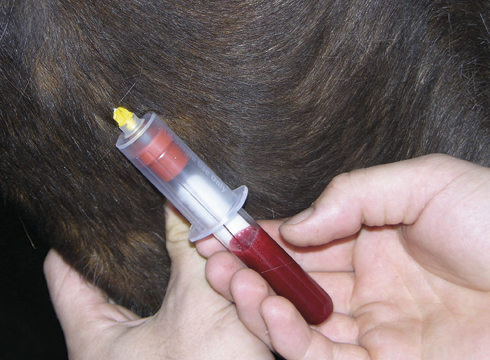Finding a horse standing in a large pool of blood, whether from a wound, a nosebleed or after foaling, is every owner’s nightmare. In many cases, the amount of blood looks more than it is and, as the horse is adapted to cope with some bleeding, this should not be a problem.
However, a wound involving a major blood vessel, blood loss during surgery and severe bleeding from a tumour can be life threatening. Rapid bleeding reduces the volume of blood in the horse’s circulation and limits its ability to deliver oxygen to the body’s tissues.
If your horse has lost a lot of blood in a short time, an emergency blood transfusion may be essential. The vet must take care to avoid adverse reactions to the transfusion, such as an allergic response.
The major benefits of a blood transfusion only last for a few days, but the new blood will provide immediate help to the horse and allow time for its own bone marrow to respond and produce a fresh supply of healthy red cells during the following few weeks.
A newborn foal suffering from haemolytic anaemia, in which the foal’s red blood cells are destroyed by antibodies absorbed from its mother’s colostrum, will also need a blood transfusion. Haemolytic anaemia occurs when the foal inherits a red cell type from its sire, which is different from its dam’s blood group. The disease can cause severe anaemia, despite there being no visible blood loss.
Blood donor
A suitable horse must be selected as the blood donor for the transfusion to minimise the chances of unfavourable side effects. The surface membranes of horses’ red cells are covered with numerous “antigens” which are used to classify horse blood into eight groups.
If red cells from a donor horse of a different blood group are added to a patient’s circulation, the patient recognises the foreign antigens and produces antibodies against the new red cells.
Generally, it is safe to give a first transfusion to a patient who has not previously received blood, even if the donor and patient are not of the same blood group. This is fortunate, as the first transfusion is frequently carried out during an emergency where there is no time to carry out a detailed cross-match.
However, if a second transfusion is performed more than a week later, the donor and recipient blood types must be matched carefully to prevent serious allergic transfusion reactions.
Plasma Transfusion
Other components of blood, such as plasma, can also be given as a transfusion. Newborn foals who do not suckle sufficient colostrum, which contains a rich supply of essential antibodies to help fight everyday bacteria, are at risk of developing life-threatening infections.
Foals can only absorb these desirable antibodies from the colostrum during the first few hours of life and, if their blood level of antibodies is low, the most efficient way to boost the levels is by a plasma transfusion.
Plasma can either be obtained by the vet taking blood from the mare and removing the red cells to collect the antibody-rich plasma, or using a commercially available plasma. The commercial plasma bags can be stored frozen so that they are always available.
Newborn foals which have not received adequate colostrum usually need about 1litre of plasma to improve their antibody status, but the vet needs to carry out follow-up blood tests to check this is sufficient.
If the foal is already sick, a larger volume of plasma may be needed to combat the effects of dehydration, infection and lack of its own immunity to disease.
|
||
 |
||


 Get up to 19 issues FREE
Get up to 19 issues FREE TO SUBSCRIBE
TO SUBSCRIBE 


